Aussiedoodles are a cross between an Australian Shepherd (Aussie) and Poodle.
Aussies, despite their name, are an American-born breed known for their hardworking nature and herding ability, such that they’ve even been dubbed the cowboy’s herding dog of choice.
Whereas Poodles, the national dog of France, were originally developed to hunt waterfowl (like ducks) and have since become one of the most popular family companions in the world.
Both of these breeds are highly intelligent, trainable, athletic, and loyal. So it’s no wonder they’re among some of the most popular breeds in dogdom.
And when you mix an Aussie with a Miniature or Toy Poodle, out comes a Miniature Aussiedoodle. These are the same as a “regular” Aussiedoodle but smaller; they typically stand up to 15 inches tall and are one of the most adorable little dogs you’ll come across.
Do they shed? Aussiedoodles (regardless of their size) can shed, but they are generally lower shedding than a purebred Australian Shepherd. And while the amount of shedding will depend on the individual dog, the more Poodle the Aussiedoodle is, the less shedding you can expect and the more “hypoallergenic” it’s likely to be.
Furthermore, while the size of the dog won’t affect its rate of shedding, small dogs have less hair on their body than standard or large-sized dogs. So, all else being equal, a Mini Aussiedoodle should drop less hair than a regular-sized Aussiedoodle.
In this post, I’ll show you what you need to know about Mini Aussiedoodle shedding to help you decide if this dog is right for you.
Recommended: Go here to see our top-rated dog hair blow dryers
How Much Do Miniature Aussiedoodles Shed?
Aussiedoodles are generally considered low-shedding dogs. However, as with any “designer” (aka mix) dog breed, its rate of shedding largely depends on genetics.
On the one hand, Australian Shepherds have a medium-length double coat that sheds moderately throughout most of the year. And they can drop more hair for several weeks at a time during spring and fall due to seasonal shedding.
On the other hand, Poodles have one layer of fur and are virtually non-shedding. They are also listed as hypoallergenic on the AKC website.
So, if your Aussiedoodle is predominately Australian Shepherd, you will likely notice some shedding, although not as much as a purebred Aussie. But if he’s mostly Poodle, chances are you’ll notice very little (if any) hair floating around the home.
How can you tell if your Aussiedoodle is more Poodle or Aussie?
Well, one thing you can do is try to determine what the genetics are of the Aussiedoodle you’re considering adopting (or already have adopted). As I discussed in this post about Bernedoodles, there are different designations given to mixed breeds depending on their genes, and knowing the difference can help you choose the lowest shedder.
Here are the different types of Aussiedoodle:
- F1 Aussiedoodle (low-shedding): This Aussiedoodle is the result of crossing a purebred Poodle with a purebred Australian Shepherd (50/50).
- F1B Aussiedoodle (lower-shedding): An F1B Aussiedoodle is what you get if you mix an F1 Aussiedoodle with a purebred Poodle (75% Poodle, 25% Aussie).
- F1BB Aussiedoodle (lowest-shedding): The F1BB Aussiedoodle comes about by mixing an F1B Aussiedoodle with a purebred Poodle (87.5% Poodle, 12.5% Aussie).
- F2 Aussiedoodle (low-shedding): The F2 Aussiedoodle is a cross between two F1 Aussiedoodles, which ultimately results in a 50/50 Poodle/Aussie mix.
So with that in mind, one way you could figure out whether your Aussiedoodle is more Poodle or Aussie would be to ask your breeder, as a reputable breeder should know whether it’s an F1, F1B, F1BB, etc. Another way would be to get a doggy DNA test online. And third, you could take the easier but less precise approach of examining the Aussiedoodle’s coat.
In short, if he looks more like a Poodle, then he’s not likely to shed much.
How can you spot the difference? Well, unlike Aussies, Poodles have curly hair, furnishings (aka facial hair) around the eyes and snout, and only one layer of hair.
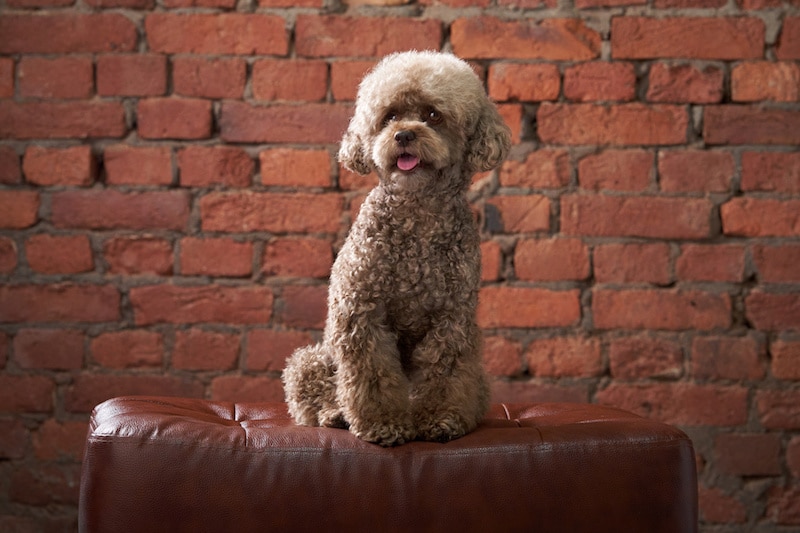
Aussies, on the other hand, have straight or wavy hair, are double-coated (i.e., they have two layers of hair), and don’t have the same type of facial hair that Poodles have.
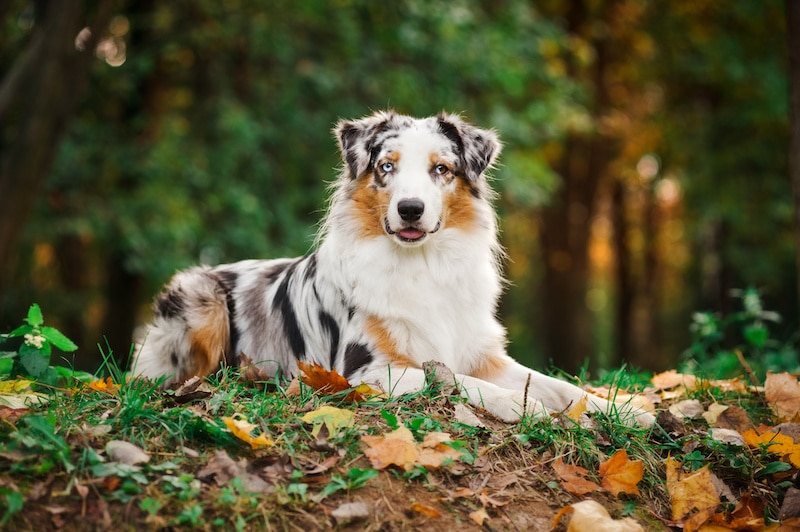
Another thing to consider when it comes to Aussiedoodle shedding is their size.
If the Aussiedoodle was bred with a Standard Poodle, they are simply referred to as an Aussiedoodle and should be of average height. Whereas Aussiedoodles that were bred with a Miniature or Toy Poodle are referred to as Mini Aussiedoodles, and these are smaller.
As mentioned earlier, the size of a dog won’t impact the rate at which it sheds hair, but it does determine how much hair they have to drop in the first place. So the smaller the dog, the less hair you are likely going to find around the home, regardless of their specific lineage.
Anyway, the take-home from everything I just said about shedding is this: Aussiedoodles don’t shed much to begin with, but the more Poodle they have in their genes, and the smaller they are, the less hair they are likely to drop.
Are Mini Aussiedoodles Hypoallergenic?
One of the most common reasons people consider getting a “Doodle” (Poodle crossbreed) dog is that not only are they less likely to shed, but they are also less likely to trigger pet-related allergies because Poodles are considered to be hypoallergenic.
Does that mean Aussiedoodles are hypoallergenic?
Not necessarily, no.
Why? Because, for one thing, there is no such thing as a 100% hypoallergenic dog. This is because all dogs produce dander (dead, flaky skin), and dander (not the hair itself) is said to be the main cause of pet allergies, along with things like saliva, urine, and sweat.
So, all dogs can be allergenic to some extent.
However, some dogs are considered hypoallergenic if they produce less dander and shed less hair (since dander and other allergens stick to hair).
With that in mind, some Aussiedoodles may be considered “hypoallergenic” if they are predominately Poodle because purebred Poodles are less likely to trigger allergies.
Therefore, as with shedding, how hypoallergenic your Aussiedoodle (or Mini Aussiedoodle) is will depend mostly on genetics. Put differently, some Aussiedoodles might cause you to sneeze, and others may not. It’s a roll of the dice.
Is Grooming an Aussiedoodle Hard?
To understand what sort of effort will be needed to groom your Aussiedoodle, miniature or otherwise, we first need to look at the parent breeds.
Australian Shepherds are pretty rugged dogs that don’t need any special grooming treatment. Their undercoat helps keep them insulated in hot and cold weather, and their medium-length outer coat is water resistant, so they are well-suited to working and playing outside. A quick brush once or twice a week with a pin brush or slicker brush should be all they need.
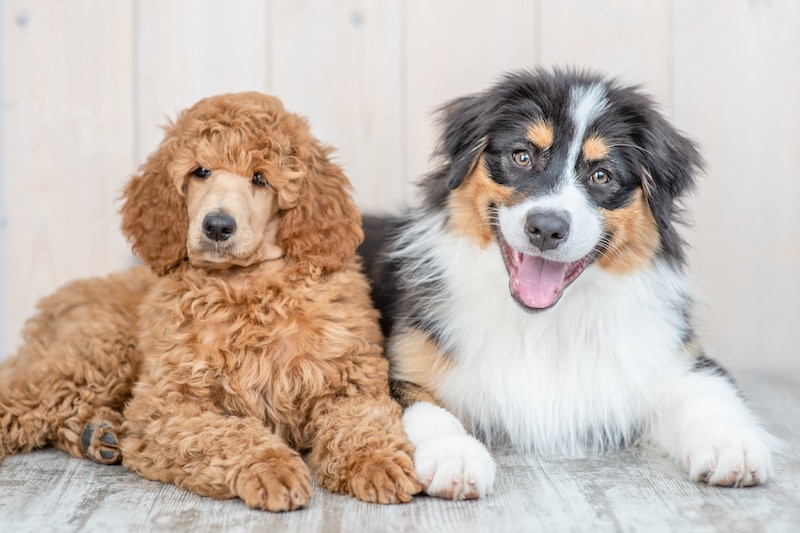
Poodles, on the other hand, are an entirely different story. They are single-coated, but their hair is long and curly and keeps on growing like human hair, which presents a couple of challenges.
First, long curly hair tends to trap more debris than straight or wavy hair (like the Aussie has) and tends to get mats, knots, and tangles, especially if they’re outside a lot. And second, because it grows so long, Poodles need to be trimmed periodically to keep the hair out of their eyes.
So, if your Aussiedoodle takes more after a Poodle, the shedding shouldn’t be much of a problem, but you will likely spend more time and effort brushing and bathing them. Instead of weekly brushing, you may need to whip out a slicker brush on a daily basis and budget for a trip to a professional groomer every month or two, depending on how Poodle-like the coat is.
On the plus side, you can trim your Aussiedoodle’s coat, which can limit the amount of grooming effort required to maintain their coat. But be careful not to trim off too much, and never remove the undercoat if he has one, as this is what protects him from the elements.
Either way, the most common experience among Aussiedoodle owners is likely to be somewhere in between the daily and weekly brushing, given the breed is part Aussie and part Poodle.
What about Mini Aussiedoodles?
Grooming a Mini Aussiedoodle should require less effort than a large Aussiedoodle because, with a smaller dog, you have less surface area to brush and bathe.
Related Questions
How can you reduce Aussiedoodle shedding?
Depending on what type of Aussiedoodle you have, you shouldn’t have to worry too much about shedding. But if yours does happen to drop a noticeable amount of hair around the place, the main things to consider are diet and grooming.
Making sure your dog’s diet is optimal, which your vet should be able to help you with, will help ensure his coat is healthy, his skin isn’t too dry, and that the hair follicles are strong.
And as for grooming, establishing a regular brushing routine will help you keep as much of the loose hair on the brush instead of your floors and furniture as possible. It can also help spread your dog’s coat oils, which in turn is good for their skin and hair.
Furthermore, you can bathe your dog periodically (once a month or so), which can help get rid of a lot of dead hair, especially when combined with a blow dry and brushing session.
There are some other ways to minimize shedding, too, but those are the main ones. And worth noting is that dogs can shed due to things like fleas, allergies, and illness. So if you have any concerns about the shedding, the safe bet might be to visit your local veterinarian.
Do Aussiedoodles with straight hair shed?
Aussiedoodles with straight hair are most likely to inherit the shedding traits of the Australian Shepherd, who, unlike the Poodle, have straight or wavy hair that sheds moderately. So if your Aussiedoodle has a straight coat, chances are they will shed more than a curly-coated Aussiedoodle.
That said, the Aussiedoodle is still likely to shed less than a purebred Australian Shepherd. And aside from seasonal coat blows, Aussies only shed moderately anyway. So worst case, it’s not like you’d be dealing with a German Shepherd or Labrador.
Are Aussiedoodles double-coated?
Some Aussiedoodles can be double-coated because the Australian Shepherd is double-coated, but it depends on the individual dog. Some will have a double coat (like the Aussie), while others will have a single coat (like the Poodle).
Do Aussiedoodles shed seasonally?
Australian Shepherds tend to shed seasonally, which means they shed more heavily twice per year (spring and fall), and this normally lasts for a few weeks at a time. So if your Aussiedoodle is predominately Aussie, it is possible that they could shed seasonally. Poodles, however, do not shed seasonally, so if your Aussiedoodle is mostly Poodle, seasonal shedding is unlikely.
Do Aussiedoodles shed their puppy coat?
All dogs shed their puppy coat, but the extent to how noticeable it is, how long it lasts, and when it occurs will depend on the individual dog. Generally, an Aussiedoodle can start shedding its puppy coat and begin transitioning to an adult coat at anywhere from 6-12 months of age.
How big do Mini Aussiedoodles get?
Because the Aussiedoodle is a mixed breed, there is no set AKC breed standard for it. But Poodles range in size from up to 10 inches (Toy), 10-15 inches (Miniature), and over 15 inches (Standard), whereas Aussies stand between 18-23 inches tall. So there are a wide variety of possible heights and no set breed standard for an Aussiedoodle.
That said, the general consensus is that Aussiedoodles will be between 10-15 inches tall and weigh between 25 to 70 pounds. So a Miniature Aussiedoodle will typically be on the low end of that scale, depending on if it’s been bred with a Toy or Mini Poodle (among other things).
Who should get a Mini Aussiedoodle?
Aussiedoodles inherit the intelligence and athletism of both the Poodle and Aussie, so they are ideal for people who are committed to training and ensuring their daily exercise needs are met. They are also described as loyal and loving and are known to make great companions.
As for apartment living, a Miniature Aussiedoodle could adapt to this as they are small, clean, not smelly, don’t drool heavily, and don’t bark excessively.
However, given their high level of intelligence and energy levels, Aussiedoodles can develop naughty habits without adequate stimulation. So they are best for someone who can provide them with plenty of exercise, training, and most of all, love!
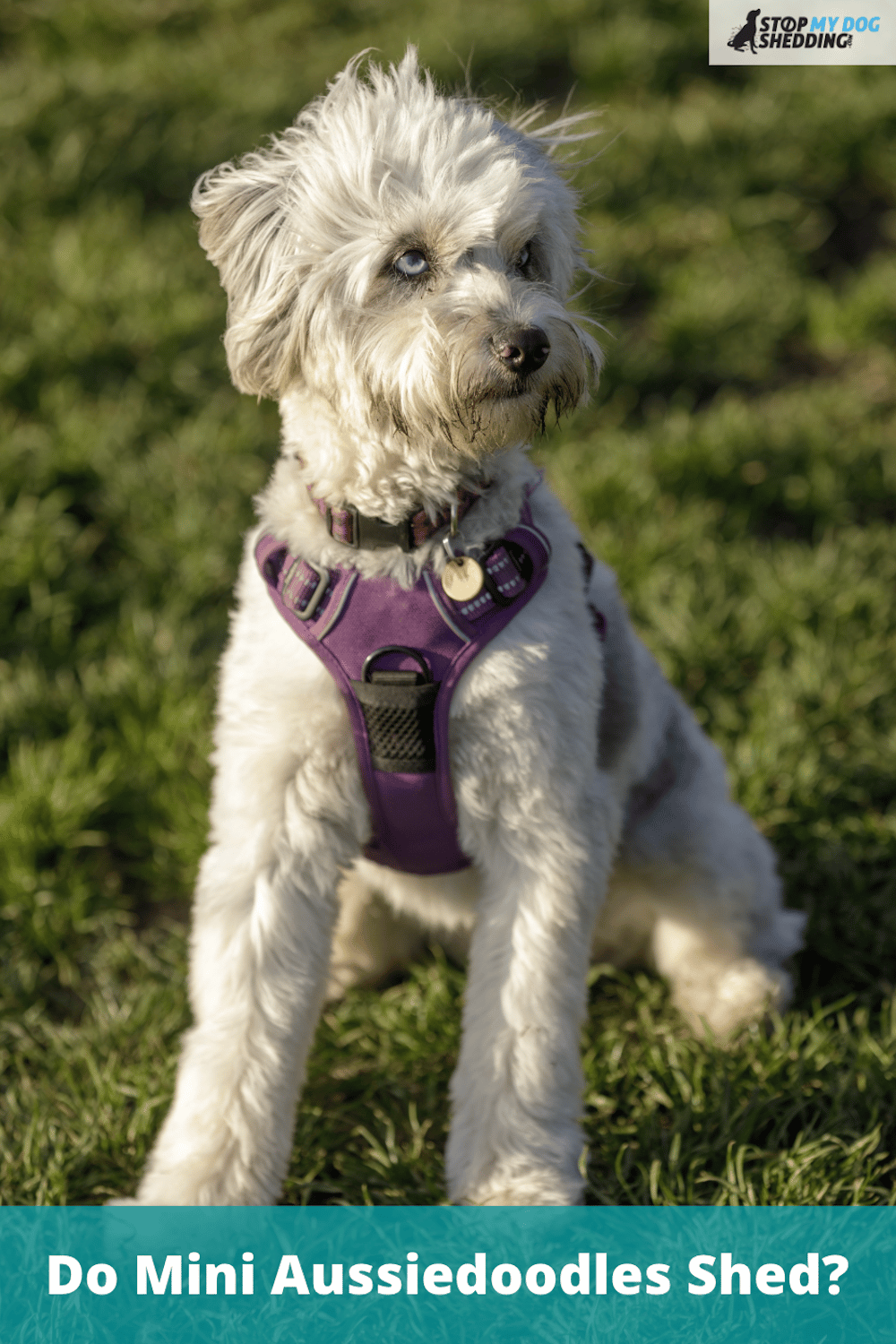

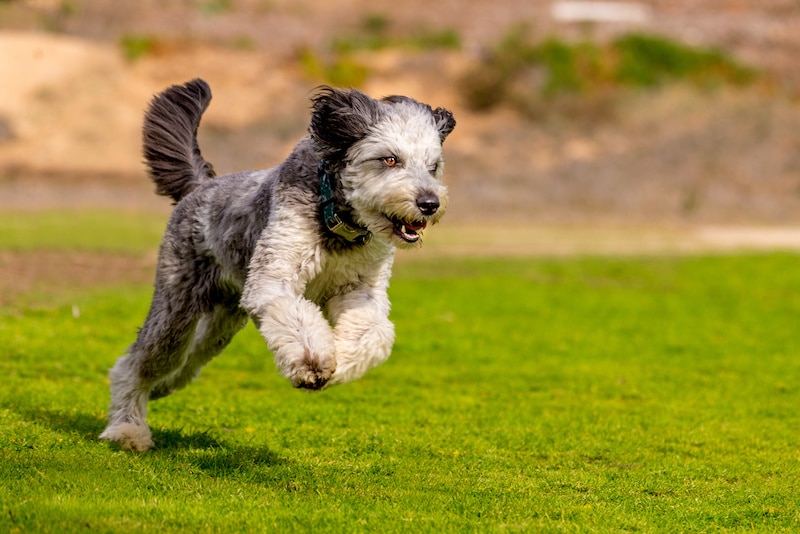










Please note: By submitting a comment using the above comment form, you confirm that you agree with the storage and handling of your data by this site as detailed in our Privacy Policy.